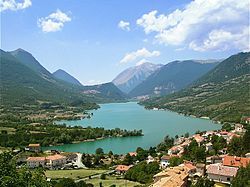Abbacy

In 999, Atenulf was given as a hostage to Duke Ademar of Spoleto after the latter raided the Principality of Capua on behalf of the Emperor Otto III. Ademar sent his hostage back to Germany. Atenulf's stay in Germany seems to have left an impression: German architectural influence is evident in the buildings he erected while abbot. He was elected abbot in 1011, and in 1014 he received a diploma from the recently-crowned Emperor Henry II. [1] On 13 March 1014, he received a privilege listing the lands of Montecassino from Pope Benedict VIII. [2]
On 5 May 1017, Princes Pandulf II and Pandulf IV granted the "church, fortified villa and castle" (ecclesia et castrum et oppidum) of Civita di Sant'Urbano to Atenulf. [3] On 10 May, they granted the land, mountain and church of Sant'Angelo in Barrea to Atenulf, who commissioned Prior Azzo to restore it, since it had escaped destruction during Muslims raids a century earlier and was still the home of a few monks. [4]
On 13 July 1019 or 1020, Atenulf received a second diploma from Henry II, confirming the abbey's possession of Sant'Urbano and Vicalvi. [3] In August and October 1017, Atenulf acquired shares in the churches of Santa Maria and Sant'Apollinare in Casalpiano. [5] In January 1020, two abbots, Peter and Paul, gave Atenulf the monastery of Saint Benedict in the diocese of Trivento, founded in February 1002, along with two churches, Santa Lucia and Santa Maria de Cruce. [6] In May 1022, Magipertus of Aquino and his wife, Anna, gave to Atenulf the region called Limata between the Liri and the town of San Giovanni Incarico and the church of San Lorenzo in the town of Aquino. [7]
Under Atenulf, the Cassinese monk Adam acquired the neglected church of San Nazario sul Melfa. Its rebuilding was credited to Adam by the historian Leo of Ostia, but on 12 April 1032 Pandulf IV and his son, Pandulf VI, confirmed the church to the abbey and granted it a mill by the Melfa because it had been rebuilt by Pandulf's brother. [8]
Later, when Atenulf fled Montecassino, he took several charters with him. One of the charters he took, granting Monte Asprano by Roccasecca to the abbey, was rescued and is extant. [9] Prior to the rule of Atenulf, the library of Montecassino was small and there was little copying of manuscripts. Under him, the scriptorium grew and books were copied in the distinct Beneventan script. His abbacy thus begins the "golden age" of Cassinese history, and especially of its library. [10]
